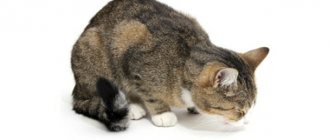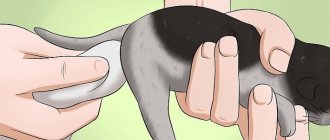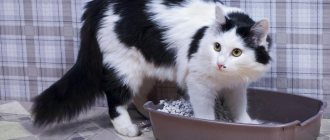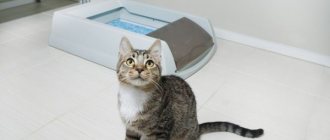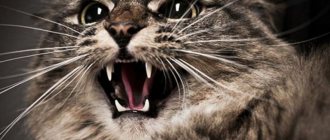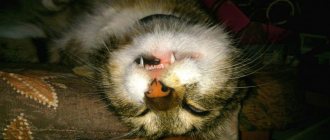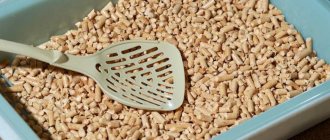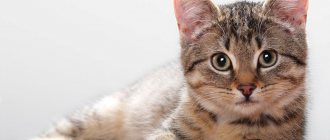12116Administration
1
The situation when a cat does not go to the toilet for a long time is quite common. There can be many reasons for such a deviation - from the most harmless to the very serious. Owners should remember that a healthy cat defecates approximately once every 1-2 days. In older animals, the period between bowel movements can stretch up to three days, but small kittens usually poop several times a day.
The frequency of trips to the toilet largely depends on the characteristics of the pet’s diet. However, if 3 or more days or even a whole week have passed since the last visit to the tray, you should be wary. Constipation may indicate serious health problems. It is imperative to find out the cause of the deviation and help the cat.
© shutterstock
Why is constipation dangerous?
Defecation is a natural process through which the intestines are freed from processed substances. If feces are retained and not released for several days, this leads to severe intoxication of the body.
When a cat is constipated, bacteria that live in the large intestine release toxins, and waste bile contains breakdown products of hemoglobin.
If a cat cannot go to the toilet for a long time, and this happens often, this is bad. This means the pet needs help. After all, systematic constipation can lead to intestinal obstruction and internal bleeding.
Why is this happening
There may be several reasons for the development of this condition:
- Acute intestinal obstruction. May develop as a result of obstruction by a foreign body (hairball, swallowed bag or cord), intussusception.
- Tumor in the large intestine. The tumor can compress the intestinal lumen and prevent the passage of feces.
- Inflammatory bowel diseases.
- Pathology of the anus. Mechanical damage to the sphincter, such as scar deformity, can make bowel movements difficult.
- Dietary disorder. Insufficient fiber and water intake, and dry food can lead to excessive dryness of stool, which makes it difficult to pass.
Something else interesting: What to do if your cat is poisoned
How to recognize difficulties
In order to recognize the pathology, it is enough to carefully monitor your pet:
- The cat goes to the toilet less than once every 2 days.
- During the act of defecation she experiences pain.
- An admixture of blood, pus or mucus is detected in the feces.
Animal treatment
You can help your pet only after discovering the cause. If the cause is scar deformity, tumor or intussusception, surgical intervention is necessary. If the condition is caused by poor nutrition, you need to reconsider your diet and add more fluid. For inflammatory diseases, antibiotics are prescribed. Symptomatic treatment is the prescription of laxatives, but these drugs can only be used after consulting a veterinarian.
Causes of constipation in cats
If your cat cannot go to the toilet in a big way, it is important to find out the cause of the problem. Constipation is not a disease, but only a symptom that indicates some kind of disorder in the body.
The main causes of constipation in cats:
- The pet drinks little. Due to lack of moisture, stool hardens and moves poorly through the intestines. This often happens when a cat is suddenly switched to dry food.
- Errors in nutrition. Feeding a cat food from the human table can lead to a lack of vitamins and microelements. Because of this, the functioning of various body systems, including the digestive system, is disrupted.
- Stress. A cat may experience constipation after experiencing a fright, a change of owner or place of residence, and a kitten may experience constipation after separation from its mother.
- Worms. Infection with parasites leads to disruption of intestinal function - stool becomes irregular, constipation alternates with diarrhea. In advanced cases, when there are a lot of helminths inside, they interfere with the movement of feces through the intestines.
- Taking diuretics or iron supplements.
- Low mobility. Elderly, pregnant cats, as well as cats with joint diseases have problems with bowel movements because they move little.
- Hairballs. Constipation often occurs due to obstruction of the intestines, as hair clumps accumulate in the intestines.
- Foreign body. If a cat swallows an object, this can also cause constipation.
- Scars in the rectum or anus.
- Distension of the intestines as a result of prolonged constipation.
- Diseases of the paraanal glands in cats.
- After childbirth and abdominal surgery, there are also stool disorders.
Attention! Older cats are more likely to be constipated. It is associated with weakened intestinal motility. In small kittens, this problem occurs due to imperfections in the digestive system.
Chronic diseases that can cause constipation in a cat
Often, constipation is accompanied by diseases that are associated with disturbances in the functioning of the endocrine system:
- diabetes;
- tumors in the rectum or anus;
- kidney pathologies;
- congenital anomalies of the gastrointestinal tract.
Spinal injuries, which damage the nerve roots of the spinal cord, lead to loss of sensation, and the cat cannot poop.
How to treat
Helping the cat should begin after identifying the source of the problem.
When a violation of the act of defecation occurs due to scar reformation, neoplasm or intussusception, surgery is required.
In case of fecal retention due to poor nutrition, the diet should be adjusted and the amount of water consumed should be increased.
If an inflammatory pathology is diagnosed, antibiotics are prescribed. Symptomatic therapy involves taking a laxative, but the use of such medications is allowed after examining the animal by a veterinarian.
Associated symptoms
Constipation does not necessarily mean a complete absence of bowel movements. Some cats have regular bowel movements, but very little feces come out. For this reason, the animal owner may not even be aware of the problem. It is important to find out in time that the cat has stool retention, before his condition worsens.
To understand that your pet needs help, you need to study the symptoms of constipation in a cat:
- the cat does not walk much for 48 hours;
- on palpation, the abdomen is enlarged and painful;
- the cat becomes restless and loses its appetite;
- the pet spends a lot of time in the tray, unsuccessfully trying to poop;
- the cat strains and meows pitifully;
- if the pet still manages to pass a large stool, then very little feces are excreted, it is dry and covered with cracks;
- there is blood in the cat's feces;
- the anus is hyperemic.
Attention! If a cat doesn't poop for more than 4-5 days, it's very bad. With prolonged constipation, signs of intoxication appear - lethargy, vomiting, and sometimes the temperature rises.
Diet to prevent constipation
For stable operation of your pet’s gastrointestinal tract, it is necessary to give him food that is enriched with protein and fiber. Completely eliminating cheese, dairy and flour products, eggs and rice from your cat’s diet will help reduce the risk of developing problems with bowel movements.
The animal needs constant access to a drinking bowl with clean drinking water and regular exercise. If the pet is not very active, then it is necessary to play with it to develop the animal’s mobility and to increase the ability to defecate if constipation develops.
What to do at home if your cat is constipated
In most cases, it is possible to improve bowel movements with the help of nutritional correction, increased physical activity, massage and laxatives. If fecal retention in a cat is caused by intestinal pathologies or tumor processes, then only surgery will help.
In cases where prolonged constipation is accompanied by vomiting, the cat is given IV drips to prevent dehydration.
Normalization of diet
To help your cat with constipation, you need to change his diet. In the first days after symptoms are detected, it is advisable to switch your pet to liquid food. Food from the human table is completely excluded from the menu - semi-finished products, sweets, foods with added salt and spices, bones.
To loosen stools, you can give a little beef liver daily.
What to include in the diet of a cat with constipation:
- vegetables – pumpkin, spinach, carrots;
- fermented milk products - classic yogurt without additives, kefir, yogurt;
- vegetable oil – no more than 1 teaspoon per day.
It is very important to increase the amount of fluid consumed. The cat should be given purified raw water.
Veterinarians recommend placing several bowls of water in different places in the apartment.
Special feed
Cats that are accustomed to dry industrial formulas are given special food with fiber, vitamins and minerals. They contain plant components, fish oil, and cereals. List of medicinal foods for cats for constipation:
- Royal Canin Fiber Response. Recommended for the treatment and prevention of diseases of the gastrointestinal tract. Duration of use for acute constipation is 1 month, for chronic constipation – up to six months.
- Hills Prescription Diet Feline w/d. Recommended for cats with diabetes, colitis and constipation. Contains a large amount of coarse fibers, which help enhance intestinal motility.
- Eukanuba Renal. Dietary cat food for constipation due to kidney dysfunction. Its difference from others is its low protein and phosphorus content.
Attention! It is very important to feed your cat as recommended by the manufacturer. Do not increase the dosage indicated on the package and do not pour food more than twice a day.
Massage and Vaseline oil
If constipation occurs, you can massage your cat's abdomen and give him Vaseline oil. It is not absorbed in the intestines, but moves along it all the way to the rectum, lubricating its walls and softening the stool.
Vaseline oil helps quite quickly: after 3-4 hours the cat goes to the toilet. The method of application is simple - you need to let the cat drink 1-2 ml from a syringe without a needle. It is advisable to do this in the morning on an empty stomach, then the oil will easily enter the rectum.
Massage helps strengthen intestinal motility. It is done 2-3 times a day for 5 minutes. The cat should not eat an hour before the procedure and 2 hours after it.
Massage technique:
- place the cat on its back on your lap;
- massage the abdominal area clockwise with your fingers.
You can help a kitten in the same way. Although it is usually the mother who massages the babies. She licks their bellies several times a day. This helps kittens go to the toilet regularly.
Laxatives
An easy way to treat constipation in a kitten is to start giving a laxative. It is worth giving preference to safe drugs. The following medications are suitable for cats:
- Duphalac Lactusan. A laxative based on lactulose, which not only softens stool well and promotes its movement, but also improves bowel function. Even a kitten can be given this medicine for constipation; it is absolutely safe.
- Microlax. This is a mini-enema with a solution for rectal administration. The composition contains substances that displace bound water from feces. The drug acts quickly - the urge to have a bowel movement occurs from the first minutes after administration of the solution.
- Normaze. Lactulose-based syrup. Effectively softens stool and promotes easy bowel movements.
Attention! Laxatives can only be given to a cat on the recommendation of a veterinarian. In some cases, their use can harm your pet.
How many days can a kitten go without walking (stress when moving)
Kittens visit the litter box up to 3 times a day. More or less is considered a deviation in the functioning of the digestive tract. The first option (increasing trips to the toilet) indicates poor functioning of the gastric mucosa.
Be sure to read:
The cat tagged: how to remove odors, the best folk and chemical remedies, how to wash clothes and shoes
The second option may be an indicator of more serious problems with the baby’s health:
- inflammation of the gastrointestinal tract;
- adhesive disease;
- hernia and scarring;
- swelling or rupture of the anal canal.
But don't panic ahead of time. Kittens also experience problematic bowel movements after a long trip, weaning from their mother's milk, or when moving to a new home. The pet needs to be given some time to adapt. If after this the animal suffers from constipation, it is necessary to consult a veterinarian.
Prolonged constipation - megacolon
If the cat does not go to poop on either the third or fourth day and at the same time behaves very restlessly, perhaps he has not just constipation, but megacolon. This is a dangerous condition that can only be diagnosed in a clinic. With prolonged constipation, dry and hard stool accumulates in the intestines.
They cannot move towards the exit and completely block the intestinal lumen.
With prolonged constipation, the cat refuses to eat, looks lethargic, and begins to vomit. If such symptoms are detected, treatment should be started immediately, but first the veterinarian must make sure that it is megacolon. You will have to do an abdominal x-ray or ultrasound.
If the diagnosis is confirmed, surgical intervention will be required, since drug treatment is ineffective.
Why can't the cat go to bed?
Oddly enough, this is a fairly common problem, especially among those breeders who save on the health of their pets. The thing is that economy-class food contains a large number of products, as well as food additives that contribute to the accumulation of salts. Thus, the environment of urine changes, and conditions are created that are favorable for the formation of stones. This is why pets who regularly eat cheap food often develop stones in the kidneys and bladder, which causes pain and difficulty defecating.
Why can't the cat go to bed:
- Congenital diseases . There are breeds that are predisposed to such diseases. They most often develop chronic diseases of the kidneys and urinary tract.
- Eating economy class food.
- Violation of containment conditions. The fact is that cats are afraid of drafts, as well as uncomfortable, uncomfortable places to rest that are not covered with fabric or a pillow.
- Consequences of sterilization. This is why it is necessary to sterilize cats at a certain age, since violation of age norms leads to the fact that they may develop problems with the urinary tract.
- Traumatization. Most often, males face urinary problems due to their aggressive nature. Cats are prone to injury and can fight, especially if they are outdoors.
- Stressful situations. Very often, communicating with dogs, traveling to exhibitions or traveling in a pet basket becomes real stress.
- Large body weight. Often occurs in males who have been castrated. Overeating contributes to obesity and the occurrence of additional pathologies, including the kidneys and urethra.
- Old age. Cats may indeed experience difficulty defecating due to old age.
cat
Preventive actions
Constipation can occur in cats of any age and breed. The animal owner should try to minimize the risk. You just need to follow these recommendations:
- Brush your cat regularly, especially during intense shedding, to prevent him from swallowing his fur;
- ensure that there is always clean water in the drinking bowl;
- Deworm the animal 3-4 times a year;
- play with the cat, because physical activity helps the intestines work better;
- do not give your pet bones;
- remove small objects from the floor so that the cat does not swallow them;
- Provide your cat with adequate nutrition - it is best to feed it with high-quality industrial formulas.
At the first symptoms of stool retention, it is better to seek veterinary help. There is no need to waste time, because the effectiveness of treatment directly depends on whether it is started on time.
How to prevent urinary retention?
To prevent the occurrence of urolithiasis, you should take care of your pet and monitor the conditions in which it is kept.
How to prevent urinary retention:
- In no case should you overfeed the animal and provoke an increase in body weight. After all, obesity often causes deterioration in the functioning of all organs.
- Conduct preventive deworming and vaccination.
- That is, it is necessary to undergo a medical examination and get vaccinations regularly.
- Under no circumstances should you give food or treats from the human table. They contain a large amount of salts and can be spicy, which causes disruption in the animal’s excretory system.
- It is worth using premium food, which is made on the basis of natural ingredients with a minimum content of additives and plant substances.
On the toilet
How to help a cat go to bed?
Initially, an adult animal should walk in a small manner at least once a day. Moving and stressful situations often become a problem. Therefore, if an animal does not go to the toilet for 2 days, it is necessary to urgently take it to the doctor. If this is not possible at the moment, you can help the animal defecate. To do this you will have to perform several simple manipulations.
How to help a cat go small:
- A small amount of warm water is filled into a plastic bottle. Please note that its temperature should be approximately 42 degrees. Under no circumstances should a heating pad with hot water be applied to the animal’s belly.
- You can put the animal in warm water and hold it for several minutes. Try not to let the warm water reach the heart area. Thus, warm water will help relieve pain and spasms. You can give the animal no-shpa to drink.
- This will help if the reason for the lack of urination is a spasm in the bladder area. If it is urolithiasis, and the ducts are blocked by stones, then such manipulations will be useless.
Filler
